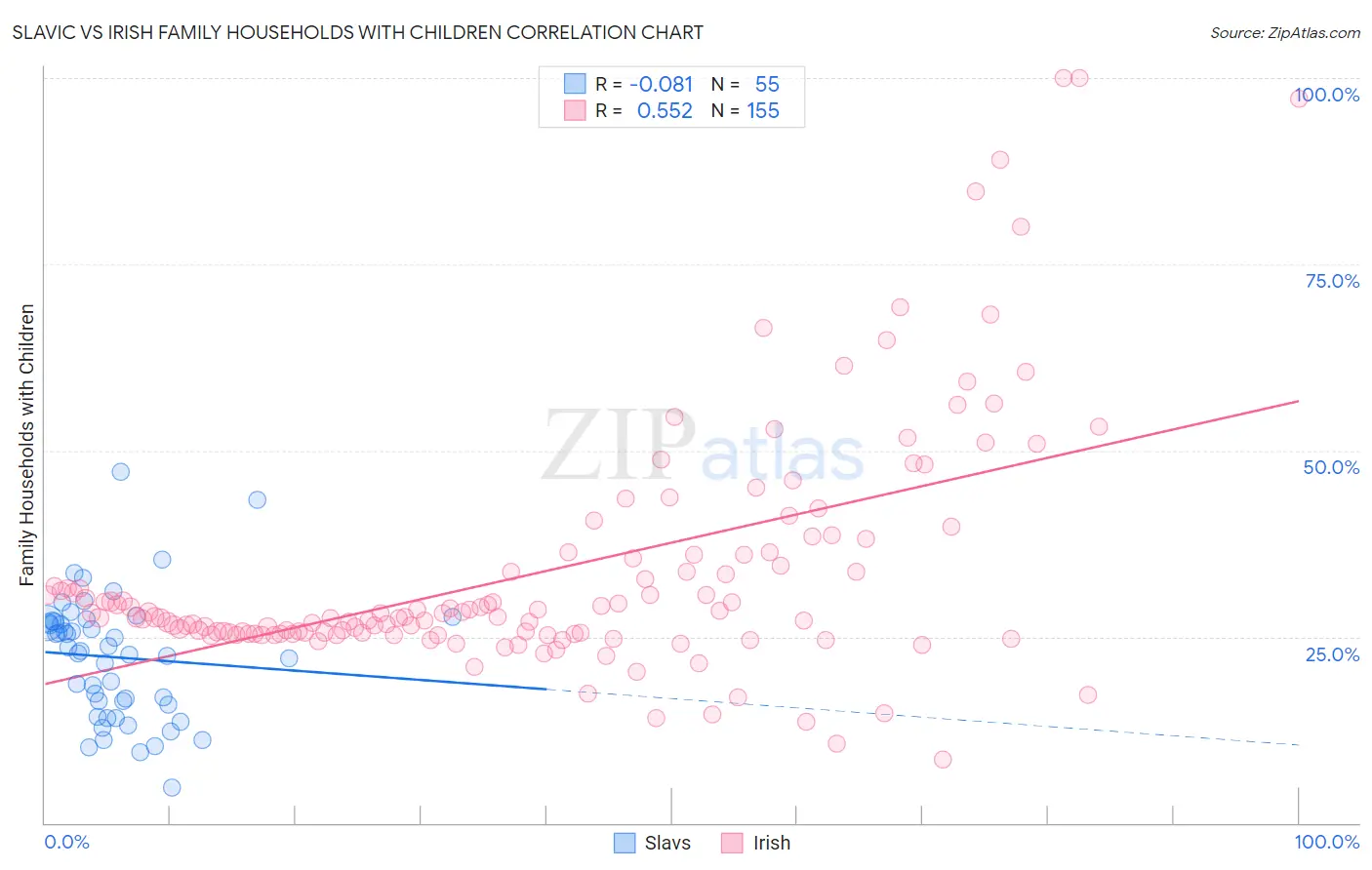Slavic vs Irish Family Households with Children
COMPARE
Slavic
Irish
Family Households with Children
Family Households with Children Comparison
Slavs
Irish
26.8%
FAMILY HOUSEHOLDS WITH CHILDREN
1.3/ 100
METRIC RATING
257th/ 347
METRIC RANK
26.8%
FAMILY HOUSEHOLDS WITH CHILDREN
1.8/ 100
METRIC RATING
252nd/ 347
METRIC RANK
Slavic vs Irish Family Households with Children Correlation Chart
The statistical analysis conducted on geographies consisting of 270,744,912 people shows a slight negative correlation between the proportion of Slavs and percentage of family households with children in the United States with a correlation coefficient (R) of -0.081 and weighted average of 26.8%. Similarly, the statistical analysis conducted on geographies consisting of 579,410,491 people shows a substantial positive correlation between the proportion of Irish and percentage of family households with children in the United States with a correlation coefficient (R) of 0.552 and weighted average of 26.8%, a difference of 0.17%.

Family Households with Children Correlation Summary
| Measurement | Slavic | Irish |
| Minimum | 4.7% | 8.5% |
| Maximum | 47.1% | 100.0% |
| Range | 42.3% | 91.5% |
| Mean | 22.2% | 33.6% |
| Median | 23.1% | 27.6% |
| Interquartile 25% (IQ1) | 15.9% | 25.4% |
| Interquartile 75% (IQ3) | 27.1% | 36.0% |
| Interquartile Range (IQR) | 11.2% | 10.5% |
| Standard Deviation (Sample) | 8.4% | 16.3% |
| Standard Deviation (Population) | 8.3% | 16.2% |
Demographics Similar to Slavs and Irish by Family Households with Children
In terms of family households with children, the demographic groups most similar to Slavs are Immigrants from Cuba (26.8%, a difference of 0.010%), Immigrants from Lithuania (26.8%, a difference of 0.040%), Scotch-Irish (26.8%, a difference of 0.050%), Immigrants from Jamaica (26.8%, a difference of 0.050%), and German Russian (26.8%, a difference of 0.060%). Similarly, the demographic groups most similar to Irish are Immigrants from Bosnia and Herzegovina (26.8%, a difference of 0.030%), Italian (26.8%, a difference of 0.080%), Belgian (26.9%, a difference of 0.090%), Immigrants from Eastern Europe (26.9%, a difference of 0.10%), and Immigrants from Scotland (26.8%, a difference of 0.10%).
| Demographics | Rating | Rank | Family Households with Children |
| Ukrainians | 2.9 /100 | #244 | Tragic 26.9% |
| Australians | 2.8 /100 | #245 | Tragic 26.9% |
| Jamaicans | 2.5 /100 | #246 | Tragic 26.9% |
| Potawatomi | 2.2 /100 | #247 | Tragic 26.9% |
| Immigrants | Kazakhstan | 2.2 /100 | #248 | Tragic 26.9% |
| Immigrants | Eastern Europe | 2.1 /100 | #249 | Tragic 26.9% |
| Belgians | 2.1 /100 | #250 | Tragic 26.9% |
| Immigrants | Bosnia and Herzegovina | 1.9 /100 | #251 | Tragic 26.8% |
| Irish | 1.8 /100 | #252 | Tragic 26.8% |
| Italians | 1.5 /100 | #253 | Tragic 26.8% |
| Immigrants | Scotland | 1.5 /100 | #254 | Tragic 26.8% |
| German Russians | 1.5 /100 | #255 | Tragic 26.8% |
| Scotch-Irish | 1.4 /100 | #256 | Tragic 26.8% |
| Slavs | 1.3 /100 | #257 | Tragic 26.8% |
| Immigrants | Cuba | 1.3 /100 | #258 | Tragic 26.8% |
| Immigrants | Lithuania | 1.2 /100 | #259 | Tragic 26.8% |
| Immigrants | Jamaica | 1.2 /100 | #260 | Tragic 26.8% |
| Immigrants | Belarus | 1.1 /100 | #261 | Tragic 26.8% |
| Immigrants | Russia | 1.0 /100 | #262 | Tragic 26.8% |
| Immigrants | North Macedonia | 1.0 /100 | #263 | Tragic 26.7% |
| Taiwanese | 0.9 /100 | #264 | Tragic 26.7% |